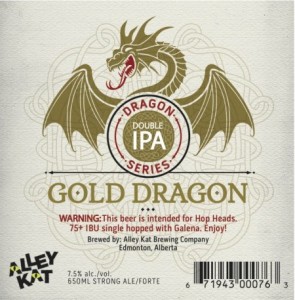 The latest Alley Kat Dragon single hop double IPA is Gold Dragon, using Galena hops. It has been out for a few weeks now, my sampling of it delayed by my Europe trip. I did finally get around to taking some time to carefully consider it, and thought it might be worthy during a slow July week to write up my notes.
The latest Alley Kat Dragon single hop double IPA is Gold Dragon, using Galena hops. It has been out for a few weeks now, my sampling of it delayed by my Europe trip. I did finally get around to taking some time to carefully consider it, and thought it might be worthy during a slow July week to write up my notes.
The beer looks exactly like its earlier siblings – medium gold with a moderately dense white head offering some admirable lacing. The aroma this time starts with the expected soft toffee and rounded grain aroma, but adds a spicy, earthy hop character. The aroma is enticing; neither too pungent nor lacking interest.
In the sip the first experience is of a soft, attractive malt base of toffee, biscuit and rounded malt. The hops start off with a resiny flavour and mouthfeel, but then becomes earthier as the beer moves back. The linger is spicy like hop tentacles with a noted bitterness. The linger builds in sharp hoppy character as the glass drains.The beer presents as fairly sweet at the beginning but then allows itself to sharpen and dry out from the hop experience.
My fuzzy beer memory suggests this is more bitter than the previous Dragons. My beer brain reminds me that bitterness is a relative matter, dependent upon many layers of factors and that all are made to the same theoretical IBU level.
But that instinctive recognition tells me something. Some hops present their bitterness more assertively than others. Some varieties, including classic British strains, prefer to be subtle in their presenation so as to not disrupt the overall balance of the beer. In certain American DIPAs, all one gets from beginning to end is hop and more hop.
Alley Kat consciously avoids the extremes. Which for some makes their Dragon Double IPA boring. What those critics don’t see is that the base beer is almost ideal for allowing the particular nature of each yeast to shine through. And that has been the success of the Dragon Series so far. The specific qualities of each hop (except for Plaid Dragon where they broke the single hop rules) are accented in these beer. I have come to learn a thing or two from them by carefully examining each beer’s profile.
Back to the beer I find the hop character is unique. Its resiny feel and multi-layered flavour presentation make the hop unusual. I don’t think many breweries use Galena as an anchor hop. The resiny feel gives the beer more hop oomph lacking in some of the others.Which I believe is attributable to the particular interactions coming from Galena.
The series continues to explore a wide range of hop options, admirably opening the world of hops to consumers in this part of the world.
As usual it won’t be around long. And, as usual, my tardy review might make your efforts to seek out a bottle more difficult. But if you can get your hands on a bottle or three, it might be worth your while, both for the beer and the education.

Leave a Reply